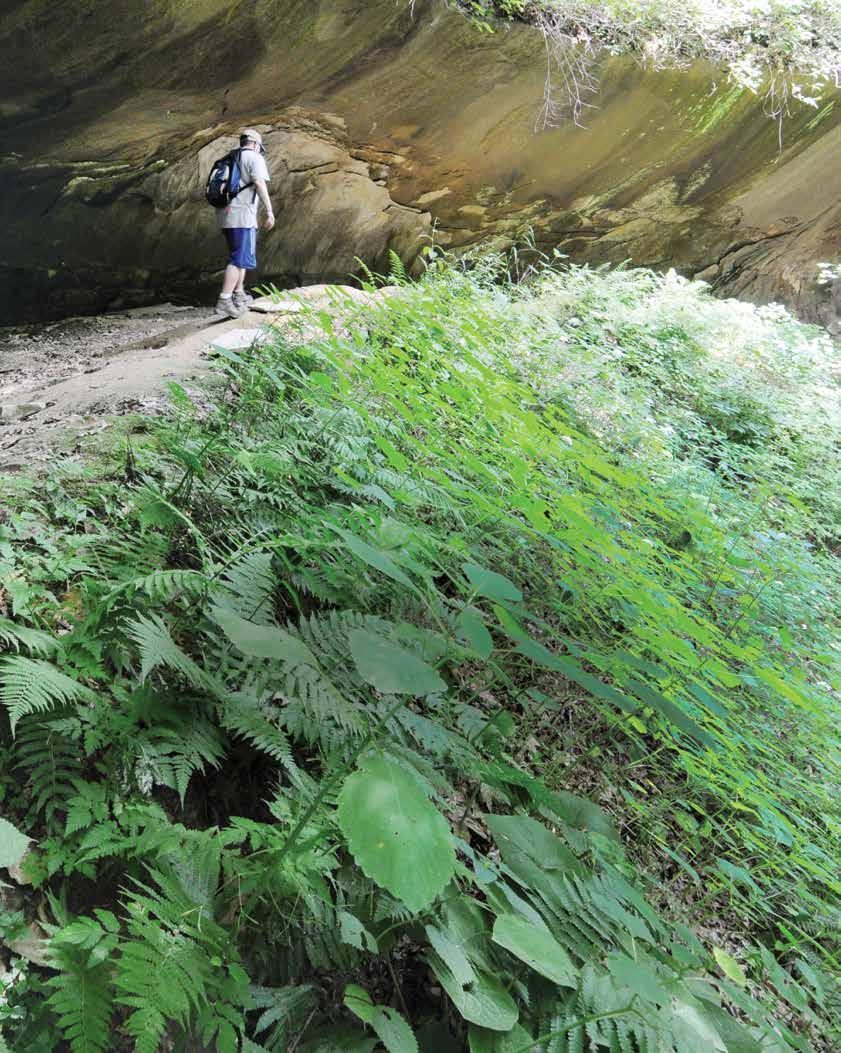
5 minute read
getting the most out of your hiking experience
story by SCoTT roBerTS photos by IndIAnA dnr
Indiana has more than 3,500 miles of public land trails waiting for hikers to explore. These pathways bring the rocks, hills, ravines, flowers, trees, and animals that dot the Hoosier landscape to those who put in the effort.
Getting out on the trail involves more than just tying your shoes and choosing a location. Douglas Wagoner, an Indiana ambassador with the Leave No Trace Center for Outdoor Ethics, says a little preparation and consideration can help make a hike the best experience, not only for you, but for everyone else in your group — and anyone who comes after you.
Check weather conditions and dress appropriately. Research the area you’ll be hiking and bring a map — make sure it’s a paper one if cellphone reception might be spotty.
Wagoner also suggests calling the property or visiting its website for any rules or special conditions management has in effect so you can make sure to follow them. He mentioned burn bans and trail closures as specifics to be aware of before setting out.
Allen Hurst, trails coordinator with DNR, said it’s important to know your limits before attempting a trail. Not all trails are created equal. If you’re just beginning your hiking regimen, start with trails rated easy or moderate before working your way up to difficult or rugged trails.
Shelbyville resident Charity Shepperd Elliott says staying at her own pace was the most important factor when she started walking trails. She found that when she was hiking near the front of a group, she would go too fast because she was trying to set the pace and would tire too quickly. Now, she usually stays near the back of the pack and lets other hikers pass. That strategy has worked. It’s allowed her to tackle parts of the nationally known Appalachian Trail, as well as multiple rugged portions of the Adventure Trail in Indiana.
“Be flexible,” Shepperd Elliott said. “Some days you feel like you can do more than others. It’s OK, just be comfortable with what you’re doing.”
Carrying a small pack with a first aid kit and snacks is also smart. And if you’re hiking alone, tell someone


Turkey run State Park has more than 14 miles of trails.
where you’re going and when you plan to be back.
On the trail, carry an extra bag or receptacle for trash. Shepperd Elliott uses her empty water bottle to stick trash in she sees along the trail, and sometimes she brings extra bottles for that purpose. Occasionally, the bottles get filled to the point of overflowing.
“My friends always tease me about it,” she said. “Maybe I should bring a bigger one, but I think it’s just something hikers should do.”
Stay on the trail unless it’s necessary to get off to let other hikers pass or to take a break.
Hurst says most trails are designed to limit their environmental impact and to make the routes as safe as possible for users. This is done by choosing a location that disturbs the least amount of plant and animal life, but also by designing around water. Because water can erode trails and make them uneven and unsafe, designing gradients and ways for the water to drain is essential.
When hikers go off trail, they can disturb this delicate balance. If enough hikers use the same off-trail area, the result may be a rogue trail. Rogues can alter the planned water flow by changing the contours of the land, making a previously safe trail unsafe. Off-trail users can also disturb wildlife and animal habitat.
If you must step off trail, watch where you step — Wagoner says to look for areas of rock or with little vegetation, places where your impact will be minimal. He says sometimes trail users may not realize that so many things outdoors are alive, and that they all have an ecological purpose.
“If an area looks like it’s sensitive to fragile plant life, walk around it,” Wagoner said. “If it’s a riparian area around marsh and lakes and streams, find another place — rock and sand are good surfaces to step on if you can find them.”
While in a group, walking in single file helps minimize impact on the trail and allows room for other hikers to pass.
When encountering hikers on a hill, always yield to uphill hikers. Do this because hikers going uphill can see less than downhill hikers. Also, uphill hikers could be in a hiking rhythm and may not want to break their pace. Uphill hikers often will let downhill hikers pass while they take a break, but it’s up to the uphill hiker to decide that.
If you’re hiking with dogs, make sure you know their limitations, too, says Elizabeth Lamport, a registered veterinary technician from the Lawrence area of Indianapolis. Take a dog first aid kit that includes vet wrap and leukotape to mend any wounds they might sustain, because their fur is different from human skin.
Keeping dogs on a 6-foot leash is required on DNR properties, and Lamport says that has saved her two dogs, both Belgian Malinois, from danger on multiple occasions. One instance was when she encountered


At Turkey run, many trails consist of deep canyons nestled within sandstone cliffs. a snake on a trail, and the leashes allowed her to keep them away.
Keeping dogs on a leash is also helpful when encountering other dogs. Some species may not like other species, and by preparing and pulling in your dogs in before you pass, you can prevent your pets from lunging at other dogs.
Finally, always bring a bag and pick up after your dogs.
The most important thing is to get out and enjoy, and, in the process, help create a welcoming environment so others can do the same. Whether you are by yourself or with a group of friends of the two-legged or fourlegged variety, Indiana has plenty to explore. For more information on responsible hiking, see www.dnr. IN.gov.










